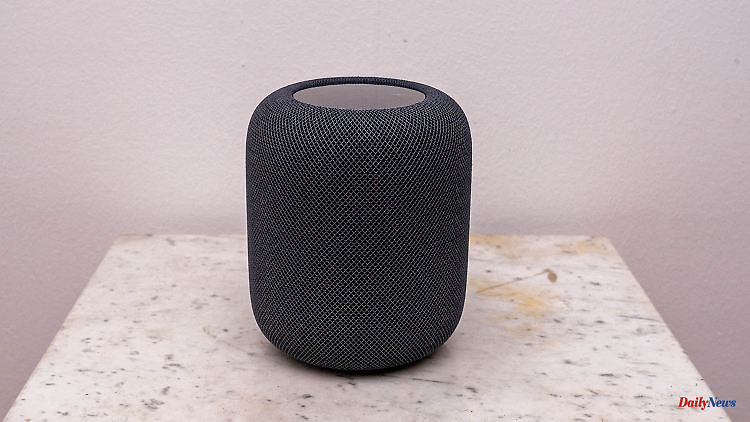The new HomePod may look like the first generation, but it's significantly better. This is mainly due to the fact that Apple has turned the right sound screws and the WLAN speaker is now a talented smart home center.
For a long time it looked as if the Homepod released in 2018 would not have a successor. Because in March 2021 Apple had stopped selling the smart WiFi speaker and only the mini version introduced in autumn 2020 was still in the range.
But now the HomePod is celebrating a comeback. ntv.de has already tried it out in a double pack.
Apple has changed almost nothing in terms of design. What is particularly striking is that the cylindrical speaker with fabric cover is now available in dark gray (midnight) instead of gray in addition to white. It is more important that the cable is plugged into the new HomePod and that a broken cable is no longer a medium-sized catastrophe.
Apple has redesigned the inner workings. In addition to an upward-facing 4-inch mid-woofer, the speaker now has five instead of seven tweeters at the bottom, which at almost 45 degrees point upwards much more than on its predecessor. Siri now listens with four microphones instead of six, and the heart of the HomePod is now an S7 chip, which is also used in the Apple Watch 7. Also new are sensors that measure air temperature and humidity.
As always, setup is very easy. After the speaker is ready to use, move the iPhone close to it and then take care of all the necessary settings by capturing a light signal from the HomePod display with the camera.
In the test, however, the Homepod bitched when it took over the connection with a repeater from the Fritzbox manufacturer AVM. With the note not to support peer-to-peer networks, Airplay, among other things, did not work. On the other hand, there were no problems with a setup in the wireless range of the router. According to forums, the problem also occurs with the HomePod mini.
Adjusting the sound to the environment is absolutely uncomplicated: the speaker automatically scans it when it starts up. If its position sensors detect that it has been moved, it does so again. In addition, the sound automatically adapts to the content being played.
As before, one cannot determine how good the adaptation is, since there is no possibility of comparison. In the test, however, the sound was always convincing, regardless of whether the HomePod was pushed into a corner, stood in the middle of a room or on a wall on a shelf.
Since ntv.de sent the first HomePod generation back after the test, it's not easy to say how much the sound has improved. What is certain, however, is that Apple has turned the right screws and has now set the bass more accurately. The biggest point of criticism of the first generation was that the basses were occasionally too dominant and sometimes even boomed.
The depths generated by the 4-inch driver with a stroke of up to 20 millimeters are still impressive for the size of the HomePod. The internal microphone responsible for this now has the bass pressure audibly under control, which is very good for the overall sound.
The lows no longer interfere with the affairs of the mids, which means that they sound even more defined than the predecessor. Voices and instruments are distributed cleanly and crystal-clear highs complement the mids perfectly with many details. Even when things get down to business, the HomePod doesn't lose its composure, nothing distorts, nothing rattles, nothing hums. All in all, the sound is now wonderfully clear and sounds almost high-resolution even with the usual MP3 material.
You can hear that it can be even better when you feed the 360-degree speaker with 3D music and it can exploit its full potential. The HomePod cannot work miracles, but it creates a beautiful surround sound. Things really fill the room when you connect two loudspeakers to form a stereo pair. As a duo, they span an enormously wide stage and the depths get more fullness. Unfortunately, you can only pair two devices of the same generation, a HomePod 1 cannot form a pair with a HomePod 2.
A pair of HomePods can also easily replace a good soundbar on the TV. The clarity of the playback is also impressive here, among other things, dialogues are very easy to understand. If you are connected to a current Apple TV 4K and the TV set supports eARC, the speakers can also play sound in Dolby Atmos. Under ideal conditions, you sometimes have the impression of hearing a helicopter overhead. However, a pair of HomePods cannot compete with a surround system.
Possibly the biggest reason for the comeback is that Apple needs a new Siri speaker to keep up in the smart home business. Because the Google Assistant and Amazon Alexa already accept commands on devices from many different manufacturers. As a smart home center, the new HomePod can not only control Apple-compatible devices, but in future all those that support the new Matter standard.
The four microphones do a good job. Even if you hear music a little louder, you don't have to raise your voice to talk to Siri. Then, as before, you can call up information, control Apple TV or make calls, for example. The possibilities of the HomePod 2 not only increase with Matter, but also with the two new sensors that measure temperature and humidity.
In the Home app, for example, you can specify that the blinds are closed when the temperature is high in summer or that a humidifier is activated when the air is dry. The corresponding automations can be dictated to Siri via the loudspeaker.
A HomePod 2 can also integrate security cameras as a smart home center, the images of which can be called up on the go from the iPhone. After an upcoming update, the speaker will also be able to recognize and report the alarm from smoke or carbon monoxide detectors.
You already know that from the competition. But Apple tries to score with data protection and privacy. The company emphasizes that with the HomePod alone or when working with an iPhone, information is only sent to Apple servers after the “Hey Siri” command or when users activate the assistant by touch. Communication is encrypted throughout and requests are not linked to the user's Apple ID.
The new Apple HomePod sounds great, and the clarity of the sound is particularly impressive. The pleasure is particularly great when used as a stereo pair. However, this is expensive fun, because a speaker costs just under 350 euros. If you want to network your home and not just integrate Apple products, the HomePod 2 is a powerful smart home center that is well equipped for the future with Matter.












